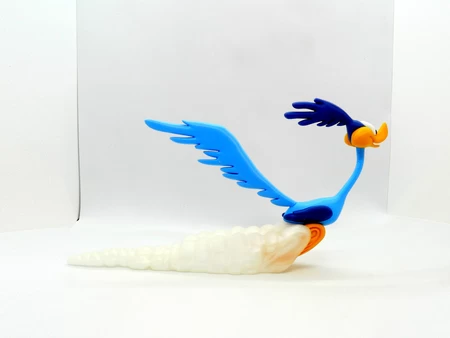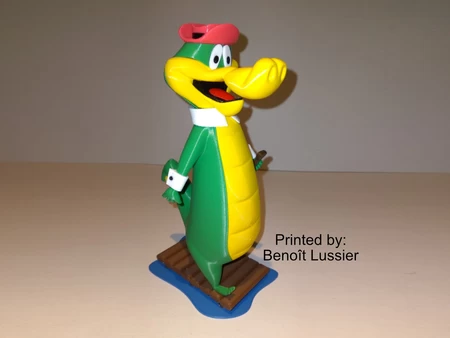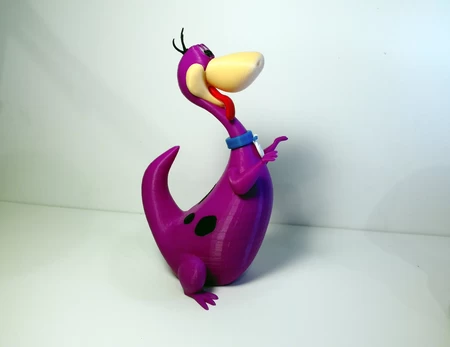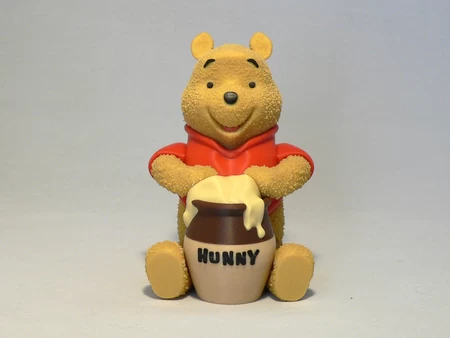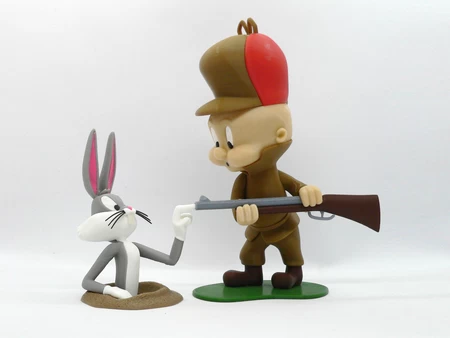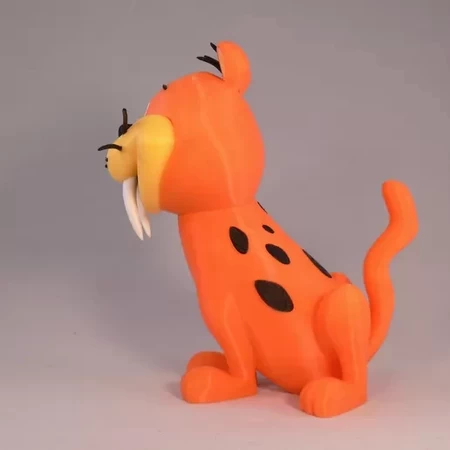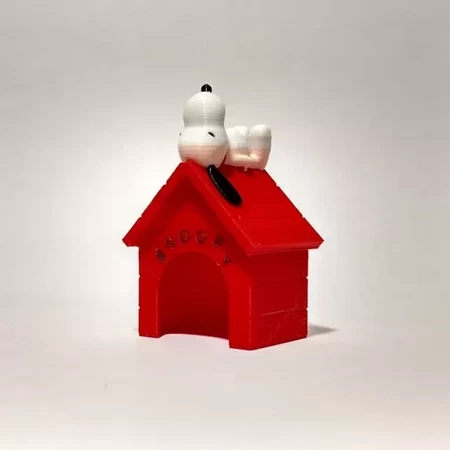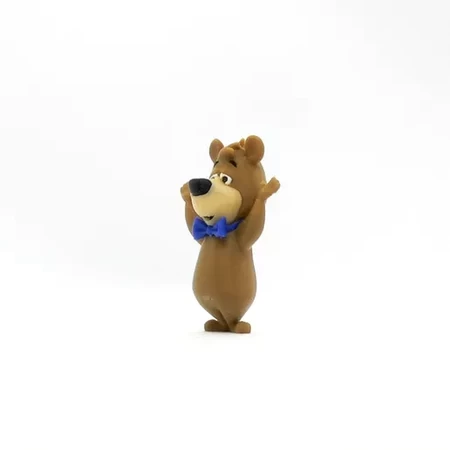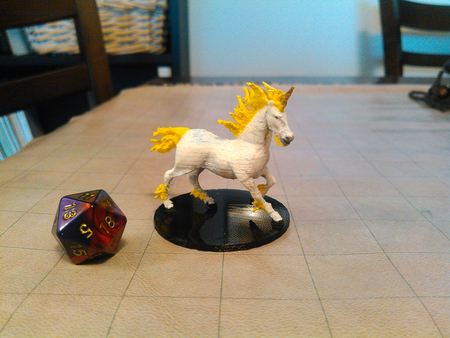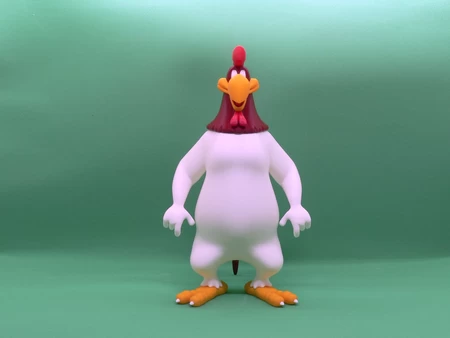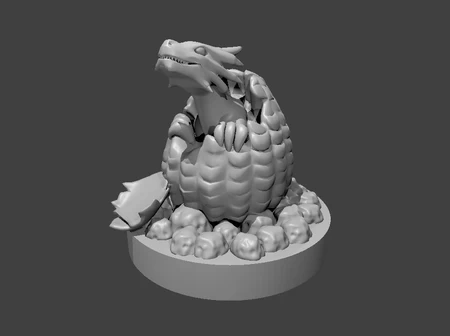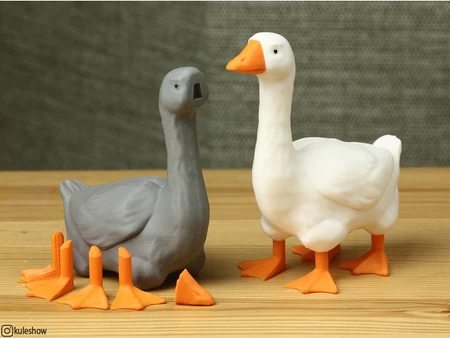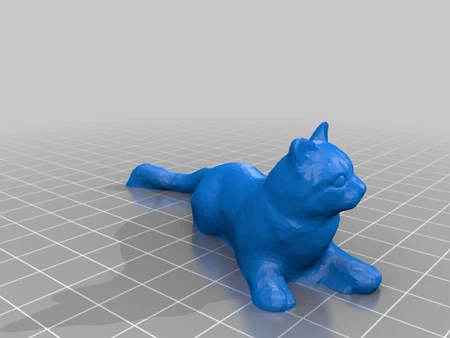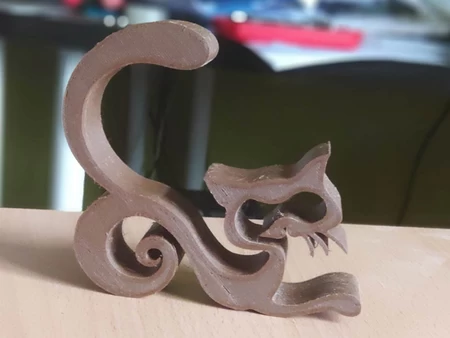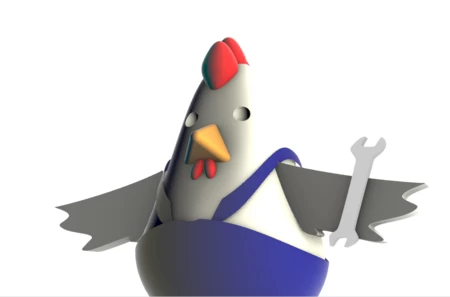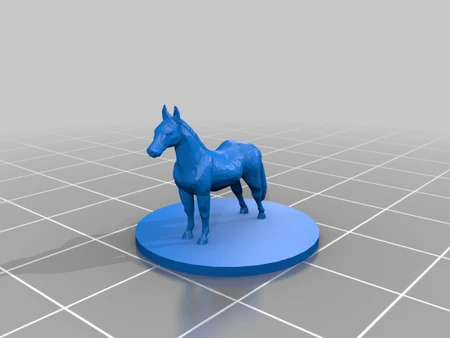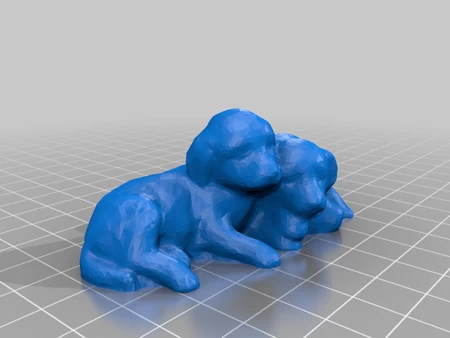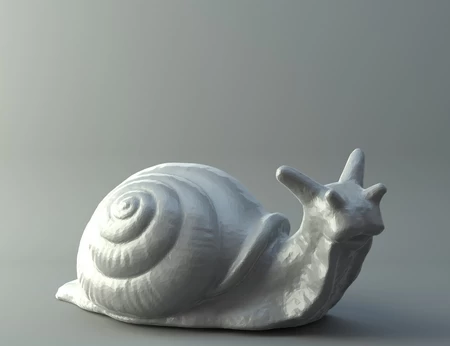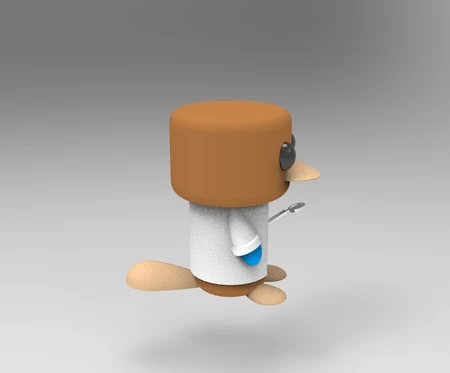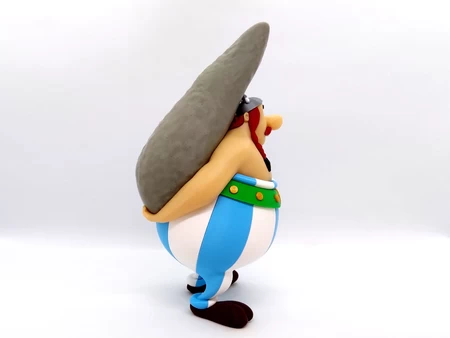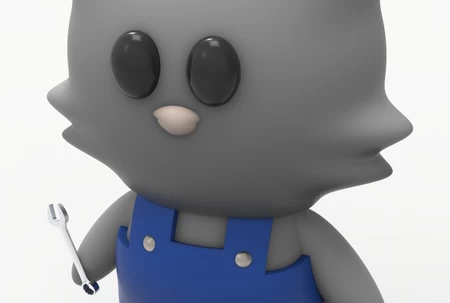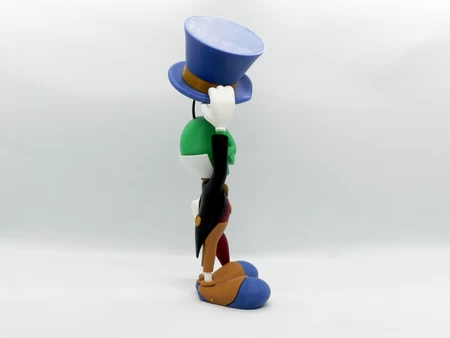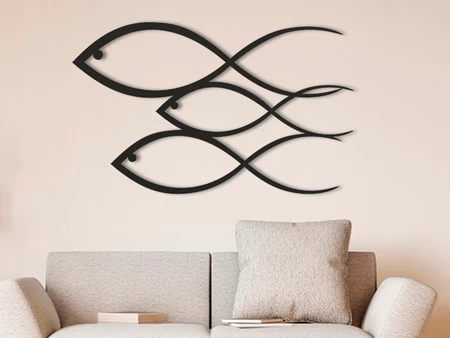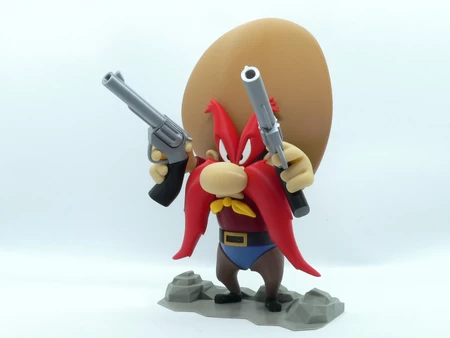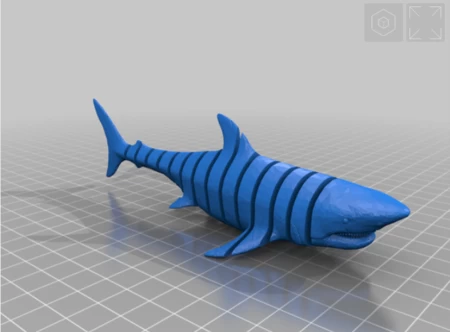Wile e. coyote 3D for print
4677 Views 2 Likes 0 Downloads Download the piece here from 3dforprint
He is a cunning, devious... and constantly hungry coyote repeatedly attempting to catch the Road Runner. Instead of using his animal instincts, the coyote uses absurdly complex contraptions to try to catch his prey, which comically backfire, with the coyote often getting injured in slapstick fashion.
No supports are required. One piece contains built-in supports and two other parts contain built-in braces. Optional parts without the built-in supports/braces are also supplied if you want to use your slicer supports (see notes below). If you have the proper filament colors, no painting is needed.
The assembled model is 175mm tall, 315mm long and is mostly in proportion to my previously released Looney Tunes models.
Resolution: .2mm
Infill: 10% (infill for body_front should be higher for strength in the arm, 20%)
Notes:**
Refer to the notes be...low for a few helpful printing and assembly instructions.
...........................................................................................................
Building the model
Colors
Black: (Paramount3D PLA - Black)
eyes_black_left
eyes_black_right
nose
cart_wheels (contains four identical pieces)
toe_nails (contains six identical pieces)
match_stick
star_black_back_left
star_black_back_right
star_black_front_left
star_black_front_right
..
Beige: (Paramount3D PLA - Universal Beige)
rope_back
rope_middle
rope_front
fuse
..
Yellow: Paramount3D PLA - Simpson Yellow)
flame_yellow
eyes_yellow_left
eyes_yellow_right
..
Orange: Paramount3D PLA - McLearen Orange)
flame_orange
..
Grey: Paramount3D PLA - Prototype Grey)
cart_leg_left
cart_leg_right
cart_pins (contains four identical pieces)
..
Blue: Paramount3D PLA - Autobot Blue)
acme (contains all the letters for ACME CO.)
..
Dark Yellow: (Paramount3D PLA - EggYolk Yellow)
star_yellow_back_left
star_yellow_back_right
star_yellow_front_left
star_yellow_front_right
..
Dark Red: (Paramount3D PLA - Iron Red)
eyes_red_left
eyes_red_right
..
Red: (Hatchbox PLA - True Red)
flame_red
rocket_nose
rocket_body
rocket_body_back (optional piece)
rocket_body_front (optional piece)
..
Light Brown: (Polyterra PLA - Wood Brown)
face
face_without_braces (optional piece)
ear_inside_left
ear_inside_right
eyebrows
..
Medium Brown: (Polymaker PLA - Army Brown)
cart_top
body_back
body_middle
body_front
bopy_front_without supports (optional piece)
ears (contains both ears with braces to make printing easier)
ear_left (optional piece)
ear_right (optional piece)
..
Any color: (hidden piece):
pin_rocket_body (optional part only needed if the two part rocket is printed)
pin_body (contains two identical pieces)
..
...........................................................................................................
Printing and assembly tips
Printing tips
1 - No supports are required. One piece contains built-in supports, body_front. An optional part without the built-in supports is also supplied if you want to use your slicer supports. The built-in supports are designed for a .4mm nozzle and for the size that the model is presented. Use your discretion for which part to use if you resize the model significantly.
2 - The right arm on body_front is a quite fragile, just below the elbow, (until the guling process which holds everything together). Be very careful when removing the supports and handling the part.
3 - Optional rocket body parts. Both a one piece rocket body as well as a split rocket body (with pin) is supplied in case your printer Z-height cannot print the one piece. My print contains the two piece rocket body, with the seam hidden by the middle rope.
4 - Optional ears parts. I tried printing the individual ears with a raft and still had a print failure due to the smallish base on the ear parts. So, I created a part that contains both ears with braces to hold them in place while printing.
5 - Face contains built-in braces to hold the part down while printing. An optional part without these braces is also supplied.
6 - There are some pieces that may need brims or rafts, use your discretion. When setting up my prints I prefer to be conservative to ensure the least chance of a print failure, especially since the base of many parts are hidden when inserted into another part.
*I used brims on:
eye_right
eye_left
toe_nails
flame_yellow
7 - When removing parts from the printer bed, it's a VERY good idea to place left/right parts into separate containers to help with the assembly process. Sometimes the difference between the left and right parts is very small but it is still worth keeping track of them and assembling them in their proper place.
..
Assembly tips:
1 - Take your time gluing the model together and enjoy the process. Dry fit all the parts and give some thought into which parts to glue together as groups and then gluing the groups together. Let the glue for each group set completely before combining groups.
2 - I used 3D Gloop and E6000 to put this model together. I am not affiliated with 3D Gloop but have experimented with different glues for my models and have found that this glue is a great option for my models. Each type of glue has different pros/cons and I found that 3D Gloop was far easier to use than superglue (for me). The E6000 sticky glue that I also use allows more time to position parts and is still the best for smaller parts. 3D Gloop covers the middle ground for me and really works wonders. It leaves enough time to set, so parts can be positioned correctly and it dries fast enough to hold awkward parts without the need for taping. I used the PLA version that comes in a tube. For both glues using a smaller amount is usually better than more glue.
3 - important The right ear (with insert) is inserted from below the right arm into the body_front. When glued, it should not only be glued at the attachment point but also to the arm to give the arm some support.
4 - The cart legs are taller in the front, to help tilt the model slightly upwards.
5 - The ropes should be flexible enough to be stretched to go over the body and rocket. Note that each rope is different and that they should fit all the indents perfectly, especially at the base. It a rope does not fit flush, flip it around.
6 - In order to get the flat ACME letters to glue properly to the rocket, I spread a thin layer of glue on the whole letter, placed it in position, and then used a heat tool or hair dryer (very low temp) to soften the letter enough that it could be pressed down. Note that one 'M' (right side) and one 'O' (left side) are cut so as not to interfere with the rope indent.
7 - Refer to the assembly diagrams in the pictures section as well as the uploaded pictures for putting the model together. The model is meant to be glued.
Do not hesitate to ask questions, feedback is essential to making better models.
Designer
Steve Solomon3d model description
Wile E. Coyote, a cartoon character in the Looney Tunes and Merrie Melodies series of short films produced by Warner Bros.He is a cunning, devious... and constantly hungry coyote repeatedly attempting to catch the Road Runner. Instead of using his animal instincts, the coyote uses absurdly complex contraptions to try to catch his prey, which comically backfire, with the coyote often getting injured in slapstick fashion.
No supports are required. One piece contains built-in supports and two other parts contain built-in braces. Optional parts without the built-in supports/braces are also supplied if you want to use your slicer supports (see notes below). If you have the proper filament colors, no painting is needed.
The assembled model is 175mm tall, 315mm long and is mostly in proportion to my previously released Looney Tunes models.
3d model print parameters
Supports: NoResolution: .2mm
Infill: 10% (infill for body_front should be higher for strength in the arm, 20%)
Notes:**
Refer to the notes be...low for a few helpful printing and assembly instructions.
...........................................................................................................
Building the model
Colors
Black: (Paramount3D PLA - Black)
eyes_black_left
eyes_black_right
nose
cart_wheels (contains four identical pieces)
toe_nails (contains six identical pieces)
match_stick
star_black_back_left
star_black_back_right
star_black_front_left
star_black_front_right
..
Beige: (Paramount3D PLA - Universal Beige)
rope_back
rope_middle
rope_front
fuse
..
Yellow: Paramount3D PLA - Simpson Yellow)
flame_yellow
eyes_yellow_left
eyes_yellow_right
..
Orange: Paramount3D PLA - McLearen Orange)
flame_orange
..
Grey: Paramount3D PLA - Prototype Grey)
cart_leg_left
cart_leg_right
cart_pins (contains four identical pieces)
..
Blue: Paramount3D PLA - Autobot Blue)
acme (contains all the letters for ACME CO.)
..
Dark Yellow: (Paramount3D PLA - EggYolk Yellow)
star_yellow_back_left
star_yellow_back_right
star_yellow_front_left
star_yellow_front_right
..
Dark Red: (Paramount3D PLA - Iron Red)
eyes_red_left
eyes_red_right
..
Red: (Hatchbox PLA - True Red)
flame_red
rocket_nose
rocket_body
rocket_body_back (optional piece)
rocket_body_front (optional piece)
..
Light Brown: (Polyterra PLA - Wood Brown)
face
face_without_braces (optional piece)
ear_inside_left
ear_inside_right
eyebrows
..
Medium Brown: (Polymaker PLA - Army Brown)
cart_top
body_back
body_middle
body_front
bopy_front_without supports (optional piece)
ears (contains both ears with braces to make printing easier)
ear_left (optional piece)
ear_right (optional piece)
..
Any color: (hidden piece):
pin_rocket_body (optional part only needed if the two part rocket is printed)
pin_body (contains two identical pieces)
..
...........................................................................................................
Printing and assembly tips
Printing tips
1 - No supports are required. One piece contains built-in supports, body_front. An optional part without the built-in supports is also supplied if you want to use your slicer supports. The built-in supports are designed for a .4mm nozzle and for the size that the model is presented. Use your discretion for which part to use if you resize the model significantly.
2 - The right arm on body_front is a quite fragile, just below the elbow, (until the guling process which holds everything together). Be very careful when removing the supports and handling the part.
3 - Optional rocket body parts. Both a one piece rocket body as well as a split rocket body (with pin) is supplied in case your printer Z-height cannot print the one piece. My print contains the two piece rocket body, with the seam hidden by the middle rope.
4 - Optional ears parts. I tried printing the individual ears with a raft and still had a print failure due to the smallish base on the ear parts. So, I created a part that contains both ears with braces to hold them in place while printing.
5 - Face contains built-in braces to hold the part down while printing. An optional part without these braces is also supplied.
6 - There are some pieces that may need brims or rafts, use your discretion. When setting up my prints I prefer to be conservative to ensure the least chance of a print failure, especially since the base of many parts are hidden when inserted into another part.
*I used brims on:
eye_right
eye_left
toe_nails
flame_yellow
7 - When removing parts from the printer bed, it's a VERY good idea to place left/right parts into separate containers to help with the assembly process. Sometimes the difference between the left and right parts is very small but it is still worth keeping track of them and assembling them in their proper place.
..
Assembly tips:
1 - Take your time gluing the model together and enjoy the process. Dry fit all the parts and give some thought into which parts to glue together as groups and then gluing the groups together. Let the glue for each group set completely before combining groups.
2 - I used 3D Gloop and E6000 to put this model together. I am not affiliated with 3D Gloop but have experimented with different glues for my models and have found that this glue is a great option for my models. Each type of glue has different pros/cons and I found that 3D Gloop was far easier to use than superglue (for me). The E6000 sticky glue that I also use allows more time to position parts and is still the best for smaller parts. 3D Gloop covers the middle ground for me and really works wonders. It leaves enough time to set, so parts can be positioned correctly and it dries fast enough to hold awkward parts without the need for taping. I used the PLA version that comes in a tube. For both glues using a smaller amount is usually better than more glue.
3 - important The right ear (with insert) is inserted from below the right arm into the body_front. When glued, it should not only be glued at the attachment point but also to the arm to give the arm some support.
4 - The cart legs are taller in the front, to help tilt the model slightly upwards.
5 - The ropes should be flexible enough to be stretched to go over the body and rocket. Note that each rope is different and that they should fit all the indents perfectly, especially at the base. It a rope does not fit flush, flip it around.
6 - In order to get the flat ACME letters to glue properly to the rocket, I spread a thin layer of glue on the whole letter, placed it in position, and then used a heat tool or hair dryer (very low temp) to soften the letter enough that it could be pressed down. Note that one 'M' (right side) and one 'O' (left side) are cut so as not to interfere with the rope indent.
7 - Refer to the assembly diagrams in the pictures section as well as the uploaded pictures for putting the model together. The model is meant to be glued.
Do not hesitate to ask questions, feedback is essential to making better models.
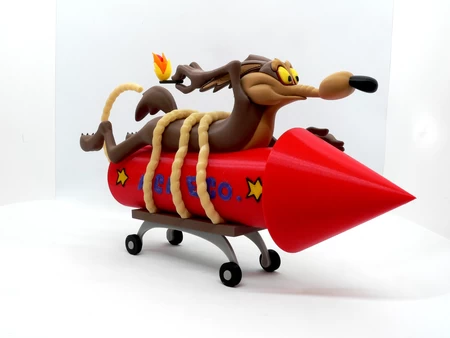
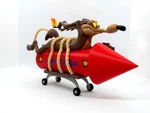
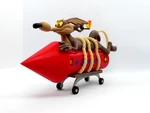
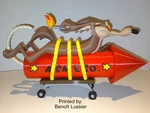
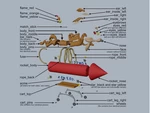
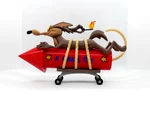
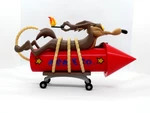
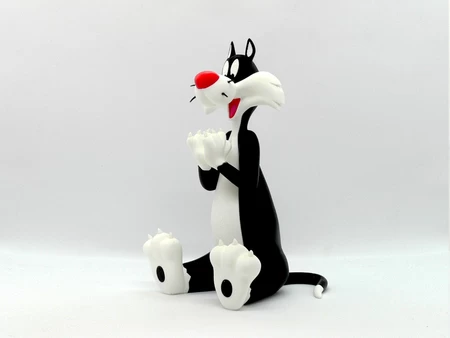
![Schnappi bust [German Cartoon Crocodile]](https://www.3dforprint.com/modelos/7291/schnappi-bust-german-cartoon-crocodile1_medium.png)
